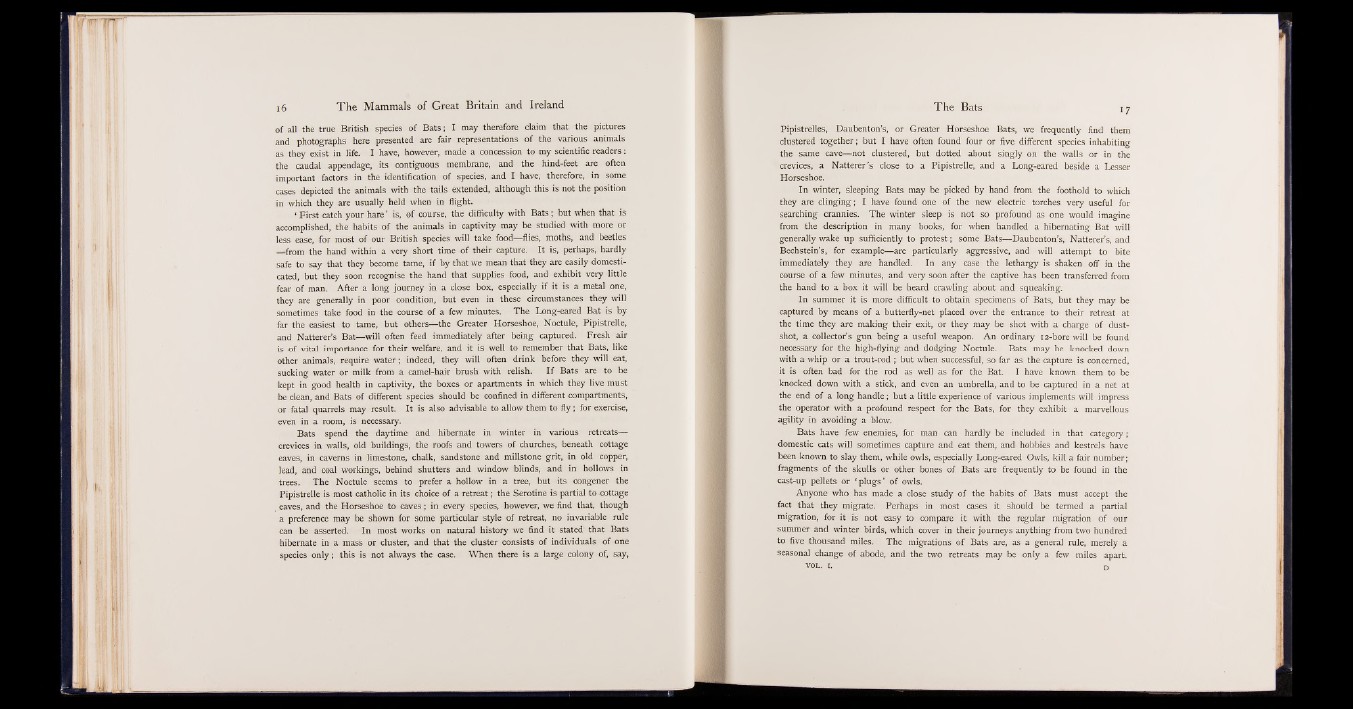
of all the true British species of Bats; I may therefore claim that the pictures
and photographs here presented are fair representations of the various animals
as they exist in life. I have, however, made a concession to my scientific readers:
the caudal appendage, its contiguous membrane, and the hind-feet are often
important factors in the identification of species, and I have, therefore, in some
cases depicted the animals with the tails extended, although this is not the position
in which they are usually held when in flight.
‘ First catch your hare ’ is, of course, the difficulty with Bats; but when that is
accomplished, the habits of the animals in captivity may be studied with more or
less ease, for most of our British species will take food— flies, moths, and beetles
— from the hand within a very short time of their capture. It is, perhaps, hardly
safe to say that they become tame, if by that we mean that they are easily domesticated,
but they soon recognise the hand that supplies food, and exhibit very little
fear of man. After a long journey in a close box, especially if it is a metal one,
they are generally in poor condition, but even in these circumstances they will
sometimes take food in the course of a few minutes. The Long-eared Bat is by
far the easiest to tame, but others— the Greater Horseshoe, Noctule, Pipistrelle,
and Natterer’s Bat— will often feed immediately after being captured. Fresh air
is of vital importance for their welfare, and it is well to remember that Bats, like
other animals, require water; indeed, they will often drink before they will eat,
sucking water or milk from a camel-hair brush with relish. If Bats are to be
kept in good health in captivity, the boxes or apartments in which they live must
be clean, and Bats of different species should be confined in different compartments,
or fatal quarrels may result. It is also advisable to allow them to fly ; for exercise,
even in a room, is necessary.
Bats spend the daytime and hibernate in winter in various retreats—
crevices in walls, old buildings, the roofs and towers of churches, beneath cottage
eaves, in caverns in limestone, chalk, sandstone and millstone grit, in old copper,
lead, and coal workings, behind shutters and window blinds, and in hollows in
trees. The Noctule seems to prefer a hollow in a tree, but its congener the
Pipistrelle is most catholic in its choice of a retreat; the Serotine is partial to cottage
eaves, and the Horseshoe to caves; in every species, however, we find that, though
a preference may be shown for some particular style of retreat, no invariable rule
can be asserted. In most works on natural history we find it stated that Bats
hibernate in a mass or cluster, and that the cluster consists of individuals of one
species only; this is not always the case. When there is a large colony of, say,
Pipistrelles, Daubenton’s, or Greater Horseshoe Bats, we frequently find them
clustered together; but I have often found four or five different species inhabiting
the same cave— not clustered, but dotted about singly on the walls or in the
crevices, a Natterer ’s close to a Pipistrelle, and a Long-eared beside a Lesser
Horseshoe.
In winter, sleeping Bats may be picked by hand from the foothold to which
they are clinging; I have found one of the new electric torches very useful for
searching crannies. The winter sleep is not so profound as one would imagine
from the description in many books, for when handled a hibernating Bat will
generally wake up sufficiently to protest; some Bats— Daubenton’s, Natterer’s, and
Bechstein’s, for example— are particularly aggressive, and will attempt to bite
immediately they are handled. In any case the lethargy is shaken off in the
course of a few minutes, and very soon after the captive has been transferred from
the hand to a box it will be heard crawling about and squeaking.
In summer it is more difficult to obtain specimens of Bats, but they may be
captured by means of a butterfly-net placed over the entrance to their retreat at
the time they are making their exit, or they may be shot with a charge of dust-
shot, a collector’s gun being a useful weapon. An ordinary 12-bore will be found
necessary for the high-flying and dodging Noctule. Bats may be knocked down
with a whip or a trout-rod ; but when successful, so far as the capture is concerned,
it is often bad for the rod as well as for the Bat. I have known them to be
knocked down with a stick, and even an umbrella, and to be captured in a net at
the end of a long handle; but a little experience of various implements will impress
the operator with a profound respect for the Bats, for they exhibit a marvellous
agility in avoiding a blow.
Bats have few enemies, for man can hardly be included in that category;
domestic cats will sometimes capture and eat them, and hobbies and kestrels have
been known to slay them, while owls, especially Long-eared Owls, kill a fair number;
fragments of the skulls or other bones of Bats are frequently to be found in the
cast-up pellets or ‘ plugs’ of owls^ ;
Anyone who has made a close study of the habits of Bats must accept the
fact that they migrate. Perhaps in most cases it should be termed a partial
migration, for it is not easy to compare it with the regular migration of our
summer and winter birds, which cover in their journeys anything from two hundred
to five thousand miles. The migrations of Bats are, as a general rule, merely a
seasonal change of abode, and the two retreats may be only a few miles apart.
VOL. I. D